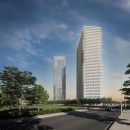Harumi Residential Towers

New York-based practice, Richard Meier & Partners has just announced that the first of the two Harumi Residential Towers planned for Tokyo has been completed. Prominently positioned in Harumi Chuo-ku City in Tokyo and adjacent to the site of the 2020 Olympic Village, the development is the first residential project in Japan to be designed by Pritzker Prize-winning architect Richard Meier. Working alongside him has been design partner and colleague, Dukho Yeon.
The project architect was New York firm, Balestri Architects. Situated on the waterfront promenade of Tokyo Bay, the project is a focal point for the Harumi district. As one of the largest and most prestigious undertakings of the Mitsubishi Jisho Residence, the Harumi Residential Towers is intended to reflect Mitsubishi’s commitment to the international and dynamic cityscape of metropolitan Tokyo. The two new towers ‘are very much part of this urban context’ according to Yeon.
Although the two Harumi Residential Towers are visually the same in massing, they are conceptualised as siblings with two unique designs, each with its own character, image and movement, but still maintaining a dialogue and harmony with one another. C1 is the first residential tower to be completed with its 883 apartments and 49 stories. The second tower – expected to be completed in April 2016 – will have 861 apartments and will also be 49 stories high. Some of the amenities shared by the residents of the towers include a terrace garden, a café lounge, special rooms for events, a fitness centre, library and guest rooms.
At equal heights of 170 meters tall, the towers capitalize on expansive views of the Harumi Canal stretching off towards the horizon. Oriented north–south as a response to urban planning requirements, the towers create an exceptionally open atmosphere of sky and seascape with views of many significant urban landmarks including the Rainbow Bridge. The Harumi Residential Towers provide a clear expression of form, space and texture using natural materials, light and reflection. The design is the result of a meticulous process of artistic craft and expression that is in harmony with its cultural, architectural and environmental context.
Richard Meier & Partners


